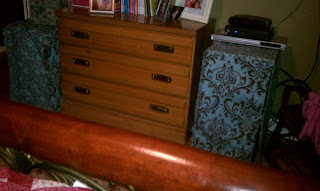Just before Thanksgiving, we toured Laura Plantation with our homeschool group. We toured another plantation last year, but this one was much more educational. However, I was tending to Audrey and Ayden so I had a hard time focusing on the guide, so my summary will be spotty.
This is the main house. It is built in Creole fashion. The houses were one story, and painted in these colors to let passers by know that french people lived here. When they say something is "creole," they are saying that it is a mix of French, Caribbean, and African.
Our tour started in the basement of the house, where we learned about the family business. Laura was a tenacious young woman who took over the business instead of her brother. She married a Frenchman whose family had a winery in France, so the basement of the house came to be a distribution center of French wine.
I didn't take any pictures inside, but one interesting point was that Laura's office was in her bedroom. When men came to conduct business, they had to go in her bedroom. This caused (of course) a little American uproar. Eventually, Laura allowed the side porch to be closed in and converted into her office, but she still required the men to pass through her bedroom to get to her office. I found that quite interesting given the time period--her tenacity, strength and determination to not allow people to push her around.
 |
| That dirt in front of those buildings used to be the kitchen. It was a large two-story building. They had to prepare a lot of food (I think it was for like 300 people), for the family members and slaves. |
At one point, the home had two wings added on to either side. They were destroyed in a fire, but they have left the foundation so you can see how big the house was at one point. They will not rebuild them because it wasn't part of the original house. The main house did not burn because of the brick construction.
There was a mini forest of these banana trees.
There are 2 slave homes left standing. This road used to be 3 miles long, with houses lining the entire path. Each home had a garden outside so that they could provide some food for themselves. The plantation owners only provided breakfast and lunch for the slaves, so they made dinner for themselves with ingredient that they grew.
 |
| The dinner bell |
This bell was rung at breakfast and lunch, to tell the slaves that the meal was ready. One person from each home had to come to the kitchen to pick up the meal for the rest of the household. I'd hate to live at the end of the 3 mile long road of houses!
This is how Jack is with every outing. Right with the tour guide, asking questions. That's my boy!
Once Laura retired from running the plantation, she had another house built on the property. Evidently, she never truly retired. They said she sat on the balcony (which deteriorated), and watched the slaves work all day with her binoculars.
The little ones really enjoyed themselves! This little boy's name is Jacob. Audrey was always a couple steps ahead of him and saying "Come on Jacob!"
Some other interesting info: Fats Domino was born here. The Br'er Rabbit stories were written here. I also learned that slaves in Louisiana were actually allowed to retire at a certain point. Basically, you were assigned a number relative to your age (a high number with a young age). Each year, your number decreased. When your number became 0, you were allowed to retire. You could still live on the plantation, be clothed and fed, but didn't have to work.
















































